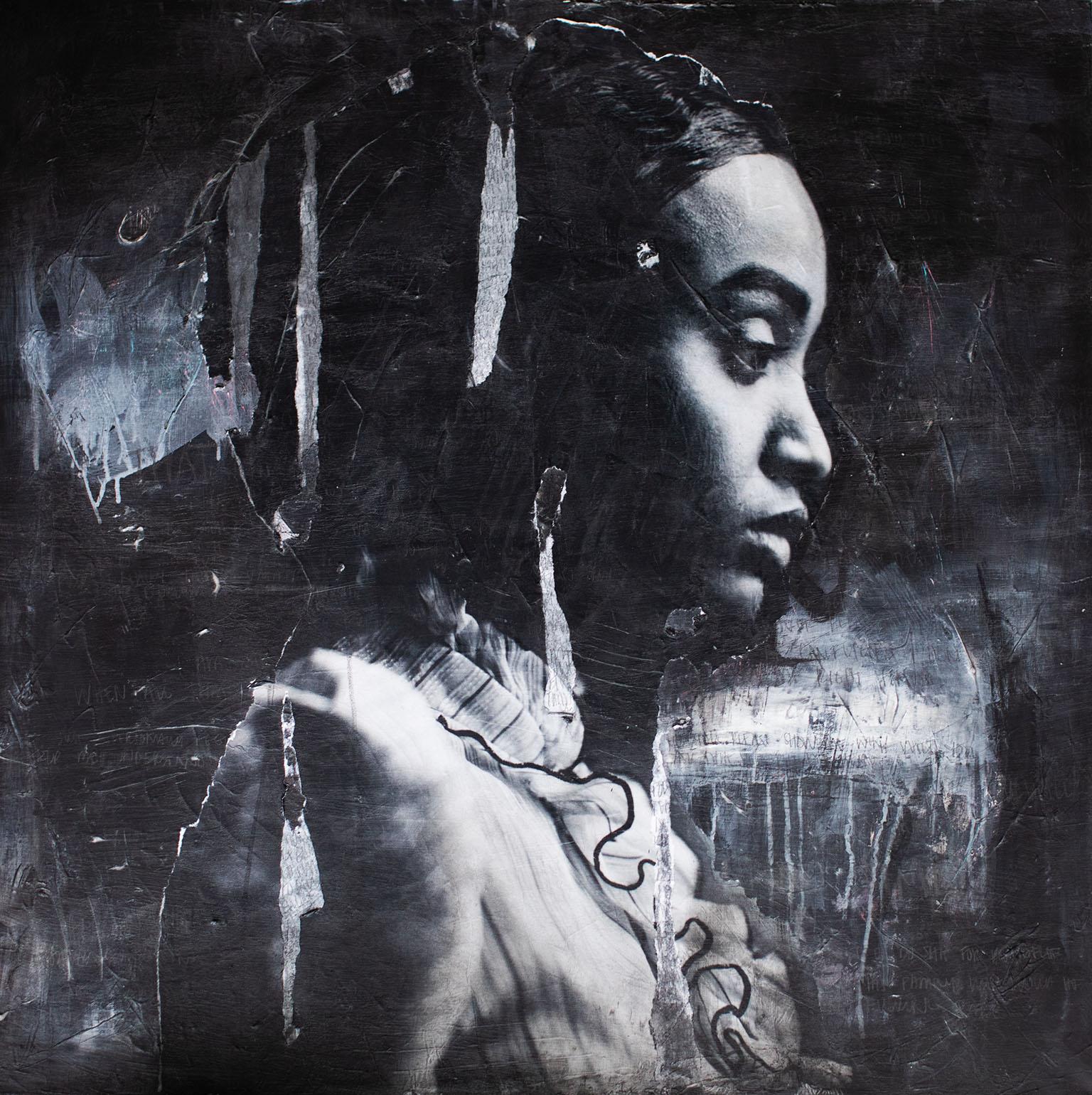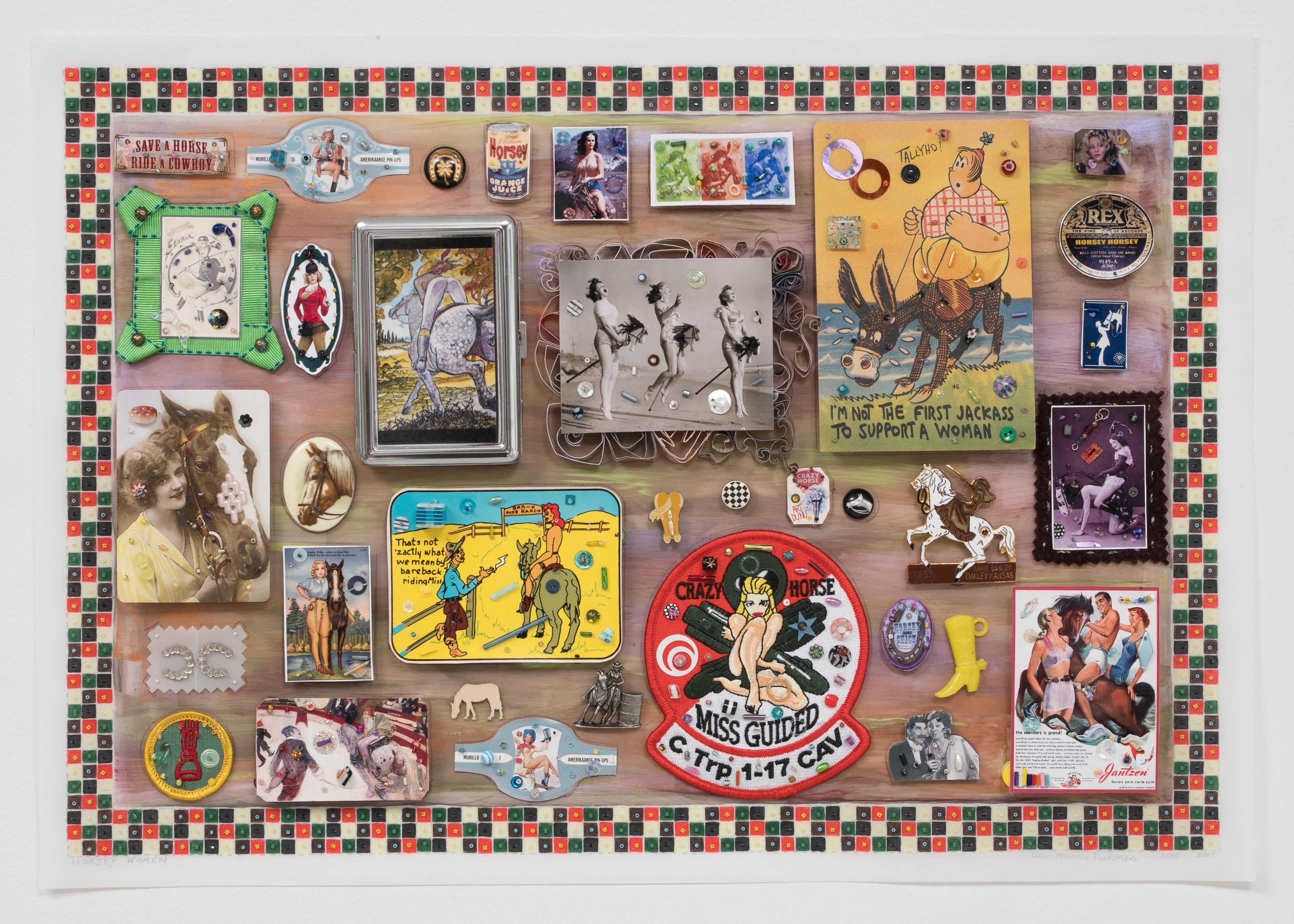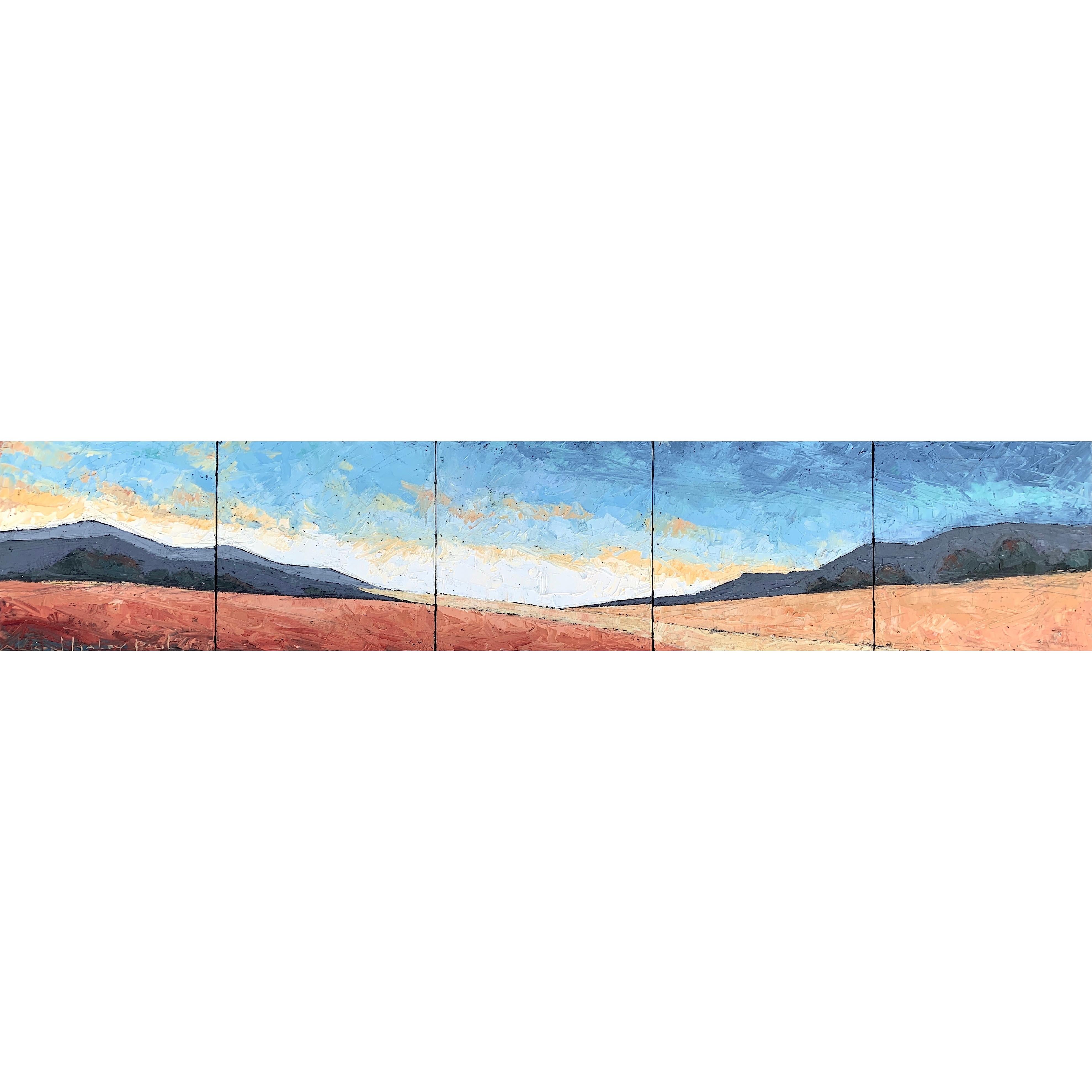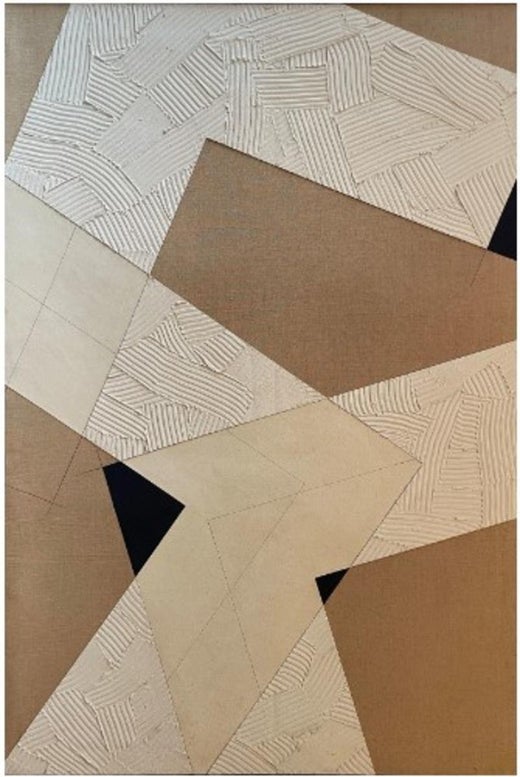Items Similar to "Villa Adrienne #17" Constructivist, Architectural, Mixed media on canvas
Want more images or videos?
Request additional images or videos from the seller
1 of 8
Georges Noel"Villa Adrienne #17" Constructivist, Architectural, Mixed media on canvas1976
1976
About the Item
Georges Noel
Villa Adrienne #17, 1976
Graphite, pigment, sand, and vinyl binder on canvas
Signed to verso
76 3/4 x 51 inches
The Pace Gallery label to verso
- Creator:Georges Noel (1924 - 2010, French)
- Creation Year:1976
- Dimensions:Height: 76.75 in (194.95 cm)Width: 51 in (129.54 cm)
- Medium:
- Movement & Style:
- Period:
- Condition:
- Gallery Location:New York, NY
- Reference Number:1stDibs: LU1841214453752
Georges Noel
Georges Noël was born in Béziers, France in 1924. He began his education as an engineering student and then studied both painting and sculpture in Pau from 1939-1945. An innovator of the art informal movement, and greatly influenced by Noveau Réalisme that emerged at this time, Georges Noël believes in gesture, objects and the accident. The imagery within each oh his paintings is inspired by primitive and archaic symbols, graffiti art and musical scores. After moving to Paris in 1955, his artistic career began to flourish, and it continued to accelerate when he relocated to the United States. Beginning in the 1950s and continuing through 2000 Georges Noël produced both canvases and works on hand-made papers, which were based on palimpsests. Palimpsests are old manuscript pages often made of parchment or vellum that have been written on, scraped off and then used again. During this process, the old writing would not be completely erased and would often still be visible. Georges Noël takes the concept of palimpsest pages and builds upon his canvasses with sculptural materials such as sand, crushed flint, and raw pigments bringing three dimensionality and vigor to each work. Georges Noël was a professor at the Minneapolis School of Art in 1969 and lived in New York from 1969-1983. He returned to Paris in 1983. The artwork of Georges Noël has been exhibited internationally and is included in the collections of the Metropolitan Museum of Art, the Bibliothèque Nationale and F.N.A.C. in Paris, and the Nationalgalerie in Berlin.
About the Seller
5.0
Platinum Seller
These expertly vetted sellers are 1stDibs' most experienced sellers and are rated highest by our customers.
Established in 2021
1stDibs seller since 2022
63 sales on 1stDibs
Typical response time: <1 hour
- ShippingRetrieving quote...Ships From: New York, NY
- Return PolicyA return for this item may be initiated within 3 days of delivery.
More From This SellerView All
- "Cronus Asleep in the Cave" Mixed Media Work on Paper by David HareBy David HareLocated in New York, NYDavid Hare Cronus Asleep in the Cave, 1971 Acrylic, ink wash, graphite, paper collage on paper on board 26 x 35 inches “Freedom is what we want,” David Hare boldly stated in 1965, b...Category
1970s Abstract Abstract Paintings
MaterialsAcrylic, Paper, Ink, Graphite
- "Cronus Dining" David Hare, Yellow and White Composition on Paper, AbstractBy David HareLocated in New York, NYDavid Hare Cronus Dining, 1968 Graphite, acrylic, paper collage on board 44 x 34 inches “Freedom is what we want,” David Hare boldly stated in 1965, but then he added the caveat, “and what we are most afraid of.” No one could accuse David Hare of possessing such fear. Blithely unconcerned with the critics’ judgments, Hare flitted through most of the major art developments of the mid-twentieth century in the United States. He changed mediums several times; just when his fame as a sculptor had reached its apogee about 1960, he switched over to painting. Yet he remained attached to surrealism long after it had fallen out of official favor. “I can’t change what I do in order to fit what would make me popular,” he said. “Not because of moral reasons, but just because I can’t do it; I’m not interested in it.” Hare was born in New York City in 1917; his family was both wealthy and familiar with the world of modern art. Meredith (1870-1932), his father, was a prominent corporate attorney. His mother, Elizabeth Sage Goodwin (1878-1948) was an art collector, a financial backer of the 1913 Armory Show, and a friend of artists such as Constantin Brancusi, Walt Kuhn, and Marcel Duchamp. In the 1920s, the entire family moved to Santa Fe, New Mexico and later to Colorado Springs, in the hope that the change in altitude and climate would help to heal Meredith’s tuberculosis. In Colorado Springs, Elizabeth founded the Fountain Valley School where David attended high school after his father died in 1932. In the western United States, Hare developed a fascination for kachina dolls and other aspects of Native American culture that would become a recurring source of inspiration in his career. After high school, Hare briefly attended Bard College (1936-37) in Annandale-on-Hudson. At a loss as to what to do next, he parlayed his mother’s contacts into opening a commercial photography studio and began dabbling in color photography, still a rarity at the time [Kodachrome was introduced in 1935]. At age 22, Hare had his first solo exhibition at Walker Gallery in New York City; his 30 color photographs included one of President Franklin Roosevelt. As a photographer, Hare experimented with an automatist technique called “heatage” (or “melted negatives”) in which he heated the negative in order to distort the image. Hare described them as “antagonisms of matter.” The final products were usually abstractions tending towards surrealism and similar to processes used by Man Ray, Raoul Ubac, and Wolfgang Paalen. In 1940, Hare moved to Roxbury, CT, where he fraternized with neighboring artists such as Alexander Calder and Arshile Gorky, as well as Yves Tanguy who was married to Hare’s cousin Kay Sage, and the art dealer Julian Levy. The same year, Hare received a commission from the American Museum of Natural History to document the Pueblo Indians. He traveled to Santa Fe and, for several months, he took portrait photographs of members of the Hopi, Navajo, and Zuni tribes that were published in book form in 1941. World War II turned Hare’s life upside down. He became a conduit in the exchange of artistic and intellectual ideas between U.S. artists and the surrealist émigrés fleeing Europe. In 1942, Hare befriended Andre Breton, the principal theorist of surrealism. When Breton wanted to publish a magazine to promote the movement in the United States, he could not serve as an editor because he was a foreign national. Instead, Breton selected Hare to edit the journal, entitled VVV [shorth for “Victory, Victory, Victory”], which ran for four issues (the second and third issues were printed as a single volume) from June 1942 to February 1944. Each edition of VVV focused on “poetry, plastic arts, anthropology, sociology, (and) psychology,” and was extensively illustrated by surrealist artists including Giorgio de Chirico, Roberto Matta, and Yves Tanguy; Max Ernst and Marcel Duchamp served as editorial advisors. At the suggestion of Jacqueline Lamba...Category
1960s Abstract Abstract Paintings
MaterialsPaper, Acrylic, Graphite
- "Repetition" Chryssa, Greek Female Artist, Abstract, Neon Light Art StudyBy Chryssa Vardea-MavromichaliLocated in New York, NYChryssa Repetition Signed lower right; titled on the reverse Gouache, watercolor, charcoal, and graphite on paper 15 x 11 inches Born and educated in Athens, Greece, Vardea Chryssa, known professionally as Chryssa, became a U.S. citizen and earned a reputation for her sculptured assemblages utilizing light from neon, and plexiglas combined with mixed media pieces. One of her pieces, Untitled Light Sculpture (1980) is 22 feet long and is installed in the atrium of a building at 33 Monroe Street in Chicago. It was programmed electronically to create changing patterns of reflected light through 900 feet of neon tubing. Chryssa's sculptures with precision and definite form were a reaction against the prevalent Abstract Expressionism of the 1950s with its emphasis purely upon the artist's intent. In her work, the focus is on materials and the way they are shaped for specific use by craftsmen. She got her early education in Athens, and first studied to be a social worker. She was then sent by the Greek Ministry of Social Welfare to the Dodecanese Islands and later to the Ionian Sea island of Zante, whose population had suffered great loss from earthquakes. Disillusioned that monies were being provided to restore monasteries but not to help other earthquake victims, Chryssa changed her life's direction to become a painter. In Athens, she studied art with Anghelos Prokopion. Then she went to Paris, France, and studied briefly at the Academie Grande Chaumiere and associated with surrealists Andre Breton, Edgard Varese, and Max Ernst. In 1954, she moved to San Francisco, California for a year of study at the California School of Fine Arts, and there she first saw the work of Jackson Pollock, which had a freeing affect on her and inspired her to experiment with pure form. But later she reacted against action painting with her assemblage sculptures of controlled precision. In 1955, Chryssa settled in New York City, and became the first artist to incorporate neon light tubing and commercial signs into sculpture. It is asserted that her "mature work grew out of the Greek experience, before and after World War II, wedded to the raucous letters, signs, symbols, and lights of Time Square, New York City" (Heller 125). In fact, she was so taken with the lights of Times Square that she unsuccessfully tried to get a job as a sign maker but was prevented by labor union rules. However, one of the members gave her sign-making lessons in his shop. She first made Pop images such as depictions of automobile tires and cigarettes and in sculptures, utilized letters of the alphabet, ideas that predated similar images by Jasper Johns and Andy Warhol. Her first major work of interwoven light and letters was Times Square Sky of 1962, but she was dissatisfied because she thought the piece was too crowded. To create a sense of breathing, she inserted neon light, and for the first time, this material became an art medium. From that time, she was prolific and created many variations based on the letters W and A. For her, a primary motivating factor was remaining cool or mentally collected amidst the onslaught of bombarding information and to process it through her creations in new ways so that nothing was repeated. She set up her own work place...Category
Late 20th Century Abstract Abstract Paintings
MaterialsGouache, Graphite, Paper, Charcoal, Watercolor
- "Cronus View from the Cave" Abstract Mixed Media Composition by David HareBy David HareLocated in New York, NYDavid Hare Cronus View from the Cave, 1971 Graphite, Ink wash, Paper Collage on Paper on Board 25 x 33 inches “Freedom is what we want,” David Hare boldly stated in 1965, but then he added the caveat, “and what we are most afraid of.” No one could accuse David Hare of possessing such fear. Blithely unconcerned with the critics’ judgments, Hare flitted through most of the major art developments of the mid-twentieth century in the United States. He changed mediums several times; just when his fame as a sculptor had reached its apogee about 1960, he switched over to painting. Yet he remained attached to surrealism long after it had fallen out of official favor. “I can’t change what I do in order to fit what would make me popular,” he said. “Not because of moral reasons, but just because I can’t do it; I’m not interested in it.” Hare was born in New York City in 1917; his family was both wealthy and familiar with the world of modern art. Meredith (1870-1932), his father, was a prominent corporate attorney. His mother, Elizabeth Sage Goodwin (1878-1948) was an art collector, a financial backer of the 1913 Armory Show, and a friend of artists such as Constantin Brancusi, Walt Kuhn, and Marcel Duchamp. In the 1920s, the entire family moved to Santa Fe, New Mexico and later to Colorado Springs, in the hope that the change in altitude and climate would help to heal Meredith’s tuberculosis. In Colorado Springs, Elizabeth founded the Fountain Valley School where David attended high school after his father died in 1932. In the western United States, Hare developed a fascination for kachina dolls and other aspects of Native American culture that would become a recurring source of inspiration in his career. After high school, Hare briefly attended Bard College (1936-37) in Annandale-on-Hudson. At a loss as to what to do next, he parlayed his mother’s contacts into opening a commercial photography studio and began dabbling in color photography, still a rarity at the time [Kodachrome was introduced in 1935]. At age 22, Hare had his first solo exhibition at Walker Gallery in New York City; his 30 color photographs included one of President Franklin Roosevelt. As a photographer, Hare experimented with an automatist technique called “heatage” (or “melted negatives”) in which he heated the negative in order to distort the image. Hare described them as “antagonisms of matter.” The final products were usually abstractions tending towards surrealism and similar to processes used by Man Ray, Raoul Ubac, and Wolfgang Paalen. In 1940, Hare moved to Roxbury, CT, where he fraternized with neighboring artists such as Alexander Calder and Arshile Gorky, as well as Yves Tanguy who was married to Hare’s cousin Kay Sage, and the art dealer Julian Levy. The same year, Hare received a commission from the American Museum of Natural History to document the Pueblo Indians. He traveled to Santa Fe and, for several months, he took portrait photographs of members of the Hopi, Navajo, and Zuni tribes that were published in book form in 1941. World War II turned Hare’s life upside down. He became a conduit in the exchange of artistic and intellectual ideas between U.S. artists and the surrealist émigrés fleeing Europe. In 1942, Hare befriended Andre Breton, the principal theorist of surrealism. When Breton wanted to publish a magazine to promote the movement in the United States, he could not serve as an editor because he was a foreign national. Instead, Breton selected Hare to edit the journal, entitled VVV [shorth for “Victory, Victory, Victory”], which ran for four issues (the second and third issues were printed as a single volume) from June 1942 to February 1944. Each edition of VVV focused on “poetry, plastic arts, anthropology, sociology, (and) psychology,” and was extensively illustrated by surrealist artists including Giorgio de Chirico, Roberto Matta, and Yves Tanguy; Max Ernst and Marcel Duchamp served as editorial advisors. At the suggestion of Jacqueline Lamba...Category
1970s Abstract Abstract Paintings
MaterialsPaper, Ink, Graphite
- "Study off Newport, Rhode Island" John Singer Sargent Drawing, ImpressionismBy John Singer SargentLocated in New York, NYJohn Singer Sargent Study off Newport, Rhode Island, 1876 Signed in pencil "JS265A" lower left Pencil on paper 5 x 10 inches Provenance: Estate of the artist Grand Central Art Galleries, New York, 1959 Mr. William H. Bender Jr Sotheby's New York, September 19, 1987 Private Collection 1987-2000 Mark Borghi Fine Art Inc., circa 2002 Private Collection (acquired from the above), New York Recognized as the leading portraitist in England and the United States at the turn of the century, John Singer Sargent was acclaimed for his elegant and very stylish depictions of high society. Known for his technical precocity, he shunned traditional academic precepts in favor of a modern approach towards technique, color and form, thereby making his own special contribution to the history of grand manner portraiture. A true cosmopolite, he was also a painter of plein air landscapes and genre scenes, drawing his subjects from such diverse locales as England, France, Italy and Switzerland. In so doing, Sargent also played a vital role in the history of British and American Impressionism. Sargent was born in Florence in 1856. He was the first child of Dr. Fitzwilliam Sargent, a surgeon from an old New England family, and Mary Newbold Singer, the daughter of a Philadelphia merchant. His parents were among the many prosperous Americans who adopted an expatriate lifestyle during the later nineteenth century. Indeed, Sargent's family traveled constantly throughout the Continent and in England, a mode of living that enriched Sargent both culturally and socially. He ultimately became fluent in French, Italian and German, in addition to English. Having developed an interest in drawing as a boy, Sargent received his earliest formal instruction in Rome in 1869, where he was taught by the German-American landscape painter Carl Welsch. Following this, he attended the Accademia di Belle Arti in Florence during 1873-74. In the spring of 1874, Sargent's family moved to Paris, enabling him to continue his training there. He soon entered the studio of Charles-Emile-Auguste Carolus-Duran. In contrast to most French academic painters, Carolus-Duran taught his students to paint directly on the canvas, capturing the essence of his subject through relaxed brushwork, a tonal palette and strong chiaroscuro. Although Sargent also spent four years studying drawing under Léon Bonnat at the Ecole des Beaux-Arts, it was Carolus-Duran's approach that would form the aesthetic basis of his style. Upon his teacher's advice, Sargent also traveled to Spain and Holland to study the work of old master painters such as Diego Velázquez and Frans Hals, both of whom also employed deft, fluid techniques. In 1876, Sargent made his first visit to the United States, claiming his American citizenship and visiting the Philadelphia Centennial Exposition. One year later, he spent the summer in Cancale, in France's Brittany region, where he painted outdoors, applying Carolus-Duran's strategies to portrayals of fishing folk on sunlit beaches. His reputation in Paris was established in 1878 when his Oyster Gatherers of Cancale (1878; Corcoran Gallery of Art, Washington, D.C.) won an Honorable Mention at that year's Salon. During the early 1880s, Sargent began making painting trips abroad, working in Venice in 1880 and 1882, where he painted street scenes and interiors notable for their brilliant play of light and shadow. He also embarked on what would be a lucrative career as a portraitist, producing such well known works as The Daughters of Edward Darley Boit (1882; Museum of Fine Arts, Boston). His early commissions also included an image of Madame Pierre Gautreau. A renowned beauty and member of Parisian society, Madame Gautreau was known for her bold, unorthodox approach towards fashion. In her portrait, entitled "Madame X" (1884; Metropolitan Museum of Art, New York), Sargent effectively captured her distinctive aura. However, his daring realism, coupled with fact that he portrayed a diamond shoulder strap falling off one of her shoulders, caused such an uproar that his career in France was seriously compromised. As a result of the controversy surrounding "Madame X,"Sargent left Paris in 1886, settling permanently in London. He subsequently flourished in the English capital, becoming the leading portrait painter to the upper classes. Those who shared Sargent's sense of refinement and sophistication, as well as his international viewpoint, were especially drawn to his fashionable French style. In addition to patronage from such prominent British families as the Wertheimers and the Marlboroughs, Sargent received an equal number of American commissions, many of them secured by artists and architects he had met during his student days in Paris, among them painters J. Carroll Beckwith and Julian Alden Weir and architect Stanford White. On a painting tour to America during 1887-1888, he portrayed members of notable families from Boston and New York, including Mrs. Jacob Wendell and Elizabeth Allen...Category
1870s Impressionist Landscape Drawings and Watercolors
MaterialsPaper, Pencil, Graphite
- "Untitled, " Alan Fenton, Abstract ExpressionismLocated in New York, NYAlan Fenton (1927 - 2000) Untitled, 1965 Charcoal and graphite on paper 23 x 17 inches Signed and dated lower right Fenton's quiet and contemplative nonob...Category
1960s Abstract Expressionist Abstract Paintings
MaterialsPaper, Charcoal, Graphite
You May Also Like
- Portrait Paintings, Black Mixed Media Art, Street Art-Era, You There?By Addison JonesLocated in Delaware , OHPortrait Paintings, Black Mixed Media Art, Street Art-Era, You There? A B O U T T H I S P I E C E : “Era, You There?” is mixed media street art by Addison Jones featuring her own po...Category
2010s Street Art Mixed Media
MaterialsCanvas, Mixed Media, Acrylic, Paint, Paper, Adhesive, Coating, Ink, Arch...
- Modern Art, Portrait Art, Black & White Painting-Big Hats And Backgrounds BlackBy Addison JonesLocated in Delaware , OHModern Art, Portrait Art, Black & White Painting-Big Hats And Backgrounds Black A B O U T T H I S P I E C E : “Big Hats and Backgrounds Black (Hannah-A2)” is ...Category
21st Century and Contemporary Modern Mixed Media
MaterialsCanvas, Paint, Paper, Adhesive, Coating, Ink, Mixed Media, Acrylic, Arch...
- "Landscape" Black an White , Original Paint on Canvas Made in ItalyBy Marilina MarchicaLocated in Agrigento, AGLandscape graphite dust on canvas relief paint original art Ready to Hang Marilina Marchica, born in 1984, was born in Agrigento, where she lives and works. She graduated in Painti...Category
2010s Contemporary Landscape Paintings
MaterialsCanvas, Acrylic, Pigment, Graphite
- "Withering on the Vine" - Abstract Expressionist Contemporary Painting, 2021Located in San Diego, CAAn original, fine art, abstract expressionist painting, "Withering on the Vine" combines abstracted floral motifs with gestural markings. Created in 2021 by a...Category
21st Century and Contemporary Abstract Abstract Paintings
MaterialsCanvas, Charcoal, Acrylic, Graphite, Pigment
- HORSEY WOMEN : contemporary collageLocated in New York, NYEllen Frances Tuchman creates contemporary collages using various ephemera such as vintage postcard, books, leather, embroidered patches, ribbon,...Category
2010s Assemblage Mixed Media
MaterialsThread, Color Pencil, Postcard, Acrylic, Mixed Media, Paper, Wood, Plast...
- QuintaBy Alison Haley PaulLocated in Napa, CAAlison Haley Paul is a contemporary painter of lavishly textured landscapes full of nuanced color. Her work conjures up connotations and geographical memories: that summer you spent ...Category
2010s Contemporary Landscape Paintings
MaterialsCanvas, Charcoal, Wax, Oil, Graphite, Pigment






